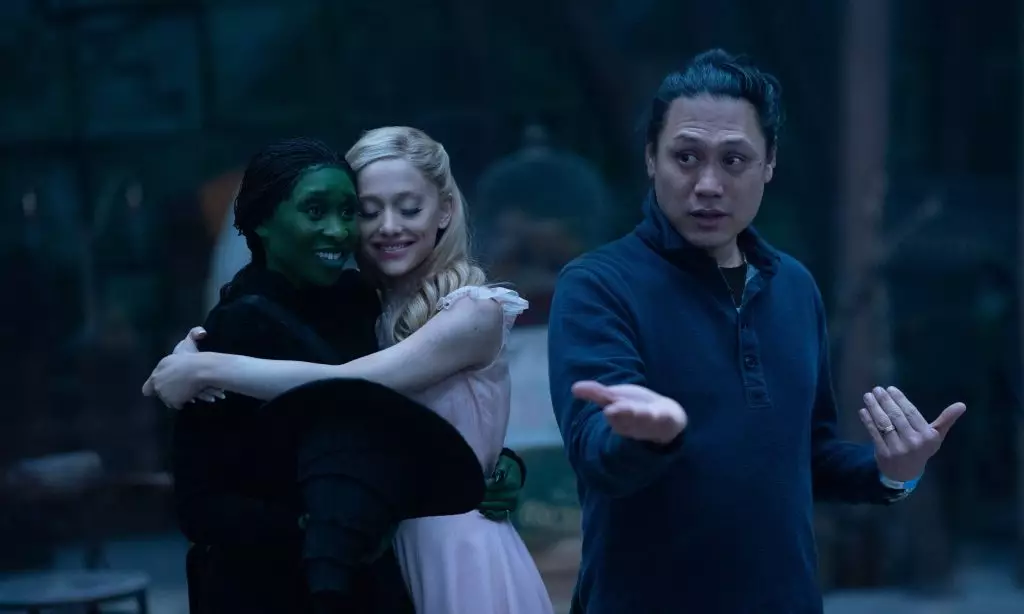The world of film often finds itself divided over the evolving interpretations of beloved classics. Jon M. Chu’s adaptation of the musical Wicked is no exception. As audiences eagerly embraced this reimagined take on the familiar universe of Oz, a notable conversation emerged surrounding its aesthetic choices, particularly its color grading. Although some fans longed for the vibrant technicolor that defined the original 1939 film, The Wizard of Oz, Chu defended his creative decisions, underscoring a desire to present Oz as a tangible world rather than a fantastical dreamscape.
In a recent interview with The Globe and Mail, Chu articulated his vision of Oz as an immersive environment, one that invites audiences not just to witness but to feel the narrative and the characters’ journeys. The film’s color grading, described by some as “a little desaturated,” was an intentional choice aimed at authenticity rather than nostalgia. Chu argued that showcasing a less saturated palette allows for a deeper emotional connection to the characters—Elphaba and Glinda—when portrayed against a backdrop that feels lived-in and real.
He pointed out that while past interpretations of Oz relied heavily on factors like matte paintings or digital renderings, his approach aimed to create a sensation of “dirt,” wear, and environmental realism, arguing that a “plastic” look would undermine the gravity of the characters’ experiences. This philosophy highlights a critical aspect of modern filmmaking—creating believable worlds that resonate with audiences on an emotional level.
The discussion surrounding Chu’s choices has sparked considerable debate among audiences and critics alike. Some have taken to social media platforms like X to voice their dissatisfaction with the film’s visual tone, characterizing it as “drab” and bland in comparison to its predecessors. Yet others advocate for the artistic merit of Chu’s approach, emphasizing that the absence of technicolor does not equate to a lack of artistry.
Historically, replicating the distinctive technicolor aesthetic has proven to be resource-intensive and technically challenging, a reality that has further fueled the debate. Chu’s perspective aligns with current filmmaking trends, which often prioritize storytelling over a purely visual spectacle. By grounding his interpretation of Oz in realism, he paves the way for audiences to engage with the characters’ struggles genuinely.
Despite—or perhaps because of—the polarizing discussion about its visual style, Wicked has performed exceptionally well at the box office. The film shattered records, claiming the title of the largest global and domestic opening for a movie adaptation of a Broadway show. This success is particularly significant given the scrutiny surrounding its aesthetic; it suggests that audiences may still seek emotional narratives and rich character arcs over traditional visual allure.
Wicked’s opening weekend saw an impressive $205 million, marking a significant achievement in the film industry, especially in pre-Thanksgiving releases. Its impact extends beyond mere numbers; the film transcended expectations and emerged as a cultural event that captivated viewers worldwide. This trend indicates a potential shift in audience preferences, away from purely aesthetic standards toward a deeper appreciation of narrative depth.
Jon M. Chu’s adaptation of Wicked presents a fascinating case study in modern filmmaking. By trading in vivid, nostalgic hues for a more grounded visual palette, he invites audiences to engage with the story on a different level. The complexity of the characters—Elphaba and Glinda—mirrored against a more subdued backdrop creates an emotional landscape that speaks of authenticity and realism.
Amidst the ongoing dialogues about visual choices, the film’s remarkable box office success reinforces a vital narrative: that storytelling can prevail even amid aesthetic critiques. As audiences become more discerning, they may increasingly favor richness in narrative and character development, proving that a great story can defy the expectations of tradition while still achieving monumental success. As we embrace this new vision of Oz, one thing is clear: the magic of storytelling is alive and well, challenging conventions and inviting us into a world that—while different—is no less enchanting.


Leave a Reply